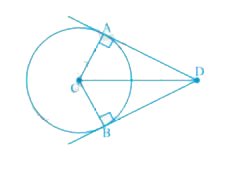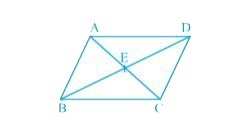What conclusion can be drawn from each part of Fig. 2.14, if
DC is the bisector of ∠ADB,CA⊥DA and CB⊥DB ?

Step by step video & image solution for What conclusion can be drawn from each part of Fig. 2.14, if DC is the bisector of angleADB,CA bot DA and CB bot DB ? by Maths experts to help you in doubts & scoring excellent marks in Class 6 exams.
Updated on:21/07/2023Topper's Solved these Questions
- GEOMETRYBOOK - NCERT EXEMPLARCHAPTER - GEOMETRYEXERCISE - Exercise (State whether the statements given in questions are true (T) or false (F):)
10 Videos
- FRACTIONS AND DECIMALS BOOK - NCERT EXEMPLARCHAPTER - FRACTIONS AND DECIMALS EXERCISE - ACTIVITY
1 Videos
- INTEGERS BOOK - NCERT EXEMPLARCHAPTER - INTEGERS EXERCISE - Exercise
42 Videos
Similar Questions
Knowledge Check
In each of the following questions two statements are given followed by two conclusions I and II. You have to consider the two statements to be true, even if they seem to be at variance from commonly known facts. You are to decide which of the given conclusions can definitely be drawn from the given statements. Indicate your answer.
Statements :
(I) Most No : 64 buses go to my office.
(II) This is a No: 64 bus.
Conclusions :
(I) This bus goes to my office.
(II) This bus does not go to my office.Aa) I and II followBb) I does not follow and II followsCc) II does not follow and I followDd) Neither followsDirections : In each of the following questions, one or two statements is given followed by four/two conclusions, I, II, III and IV. You have to consider the statements to be true, even if it seems to be at variance from commonly known facts. You are to decide which of the given conclusions can definitely be drawn from the given statements. Indicate your answer.
Statements :
Some boys are men.
No man is black.
Conslusions :
I. Some boys are not black.
II Some men are boys.AOnly Conclusion I followsBOnly Conclusion II follows.CBoth I and II followsDNeither I nor II followsFluorine is more electronegative than either boron or phosphorus. What conclusion can be drawn from the fact that BF3 has no dipole moment nut PF3 does ?
ABF3 is not spherically symmetrical but PF3 isBBF3 molecule must be linearCThe atomic radius of P is larger than that of BDThe BF3 molecule must be planar triangular
In △ABC,BE⊥AC,CD⊥AB and BE and CD intersect each other at O. The bisectors of ∠OBC and ∠OCB meet at P. If ∠BPC=148∘, then what is the measure of ∠A ?
त्रिभुज ABC में, BE⊥AC,CD⊥AB तथा BE और CD एक दूसरे को O पर काटती हैं | ∠OBC तथा ∠OCB के समद्विभाजक P पर मिलते हैं | यदि ∠BPC=148∘ है, तो कोण A का मान क्या है?
View SolutionThe lengths of the tangents drawn from the vertices A, B and C to the incicle of ΔABC are 5, 3 and 2, respectively. If the lengths of the parts of tangents within the triangle which are drawn parallel to the sides BC, CA and AB of the triangle to the incircle are α,βandgamm, respectively, then the value of [α+β+γ] (where [.] respresents the greatest integer functin) is _____
View SolutionIn each of the following question statement is followed by two conclusions I and II. You have to consider the statement to be true, even if it seems to be at variance from commonly known facts. You are to decide which of the given conclusions can definitely be drawn from the given statement. Indicate your answer.
Statement :
Light comes from the Sun; feathers are light.
Conclusions :
I. Feather comes from the Sun.
II. Sun is light.
View SolutionWhich of the following is not a direct conclusion that can be drawn from Mendel's Experiment ?
a) Only one parental trait is expressed
b) Two copies of each trait is inherited in sexually reproducing organism
c) For recessive trait to be expressed, both copies should be identical
d) Natural selection can alter frequency of an inherited trait.
View SolutionIn each of the following questions, one or two statements is/are given followed by two conclusions I and II. You have to consider the statements to be true, even consider the statement to be tue, even if it seems to be at variance from commonly known facts. You are to decide which of the given conclusions can definitely be drawn from the given statement. Indicate your answer.
Statements : Cactus plants are fleshy but need least water.
Conclusions :
I. All fleshy plants are cactus.
II. Cactus plants need least water.
View Solution


